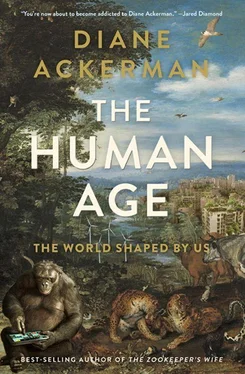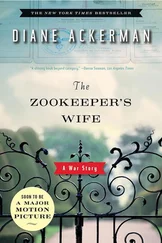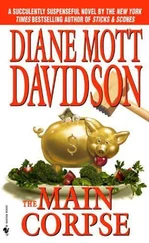Behind all of Bren’s enthusiasm is a wave of widely shared concern about how climate change is acidifying the seas. He’s part of a transitional generation that feels the urgency of reconciling their lifestyle with the planet’s health. Call it what you will, pioneering or bioneering, because of his commitment, he was invited to join the Young Climate Leaders Network, which supports a small group of “innovative leaders and visionaries, including many who operate largely outside of the traditional environmental community, working for climate solutions.”
Bren’s eyes rest on the water. “There’s no doubt, this will mean reimagining the oceans, which is heart-wrenching and controversial for a lot of people who revere the oceans as some of the last wild places on Earth, places untouched by human hands.”
Yet the truth is that oceans are not untouched by human hands. In 2007, owners of the only salmon farm in Ireland woke one day to find its hundred thousand salmon devoured by a horde of jellyfish. Throughout the world’s oceans, trillions of umbrella, parachute, and bell-shaped jellyfish have been swarming, lured by rising temperatures, nutrient-rich agricultural runoff, and pollution. With semitransparent stealth, they sneak up on flounder, salmon, and other large fish favored by human fishermen and colonize a slew of habitats, where they eat or oust the local fish. Oceana Europe, which works to restore and protect the world’s oceans, attributes the soaring number of jellyfish to climate change and the human overfishing of tuna, swordfish, and other natural predators. City-dwellers are combating blooms of jellyfish in Tokyo, Sydney, Miami, and other harbors. During one recent summer, record numbers invaded the shallows of South Florida and the Gulf of Mexico. In Georgia, on one Saturday alone, Tybee Island Ocean Rescue reported two thousand serious stings.
The sea is a spirit level, a pantry, a playground, a mansion rowdy with life, a majestic reminder of our origins, another kind of body (a body of water), and female because of her monthly tides. But her bones are growing brittle, her brine turning ever more acidic from all the CO 2we’ve slathered into the air and all the fertilizer runoff from our fields. While that’s terrible for creatures like coral, oysters, mussels, and clams, whose calcium shells can soften and dissolve, the warmth is a tonic for starfish, which are roaming farther north in throngs. Until, that is, their shellfish prey vanish.
“Environmentalists have been asking the wrong question,” Bren says after a moment. “It’s not just about: How can we save the oceans? How can we protect the sea animals? I agree, all of that’s important. But we also need to flip our way of thinking and ask: How can the oceans save us ? How can it provide food, jobs, safety, and a sustainable way of life? I’m convinced the answer is ocean conservation with symbiotic green farms.”
Last thing, we check the remaining crop of mussels, which means back-straining, heave-hauling them up from the depths where they’re filling their mesh socks nicely, growing through the lattices like shiny black buttons, still too small for harvesting. So back they descend, too young for saffron cream sauce. I can see why he finds this part of his workday like checking on a nursery.
Scanning the lapping ripples of the Sound, it doesn’t look like an industrial landscape at all. And yet the amount of food growing below the water is incredible. There are two tons of kelp on Bren’s longlines alone. I like Bren’s “symbiotic” way of thinking. We billions of creative, problem-solving humans don’t have to be parasites in our environment—we have the technology, the understanding, and the desire to become ecologically sustaining symbionts.
On our return to Stony Creek harbor, we again pass the island-perched village of Victorian mansions and salt-white cottages, with stone chimneys for burning up yesterday’s disappointments, rain-rattled windows, sea-spying porches, and wind-worn trees and gardens. And always the deep and dazzling blue of the Sound, with hidden reefs and ledges, devious currents corkscrewing just below the surface, and, during storms, waves running like greyhounds.
The new dock looks trim, clean, and stubbornly well anchored against hurricanes. A pair of black cormorants perches on a rocky knob, and Bren gestures a welcome. Superstition tells of drowned fishermen returning as hungry cormorants, dressed in black rain gear, with webbed feet instead of boots.
Despite the cold breeze there’s a warm afternoon sun. Soon the tide will be walking in and the pink-legged seagulls skimming the shoreline. In a few months the summer crowds will arrive to eat fresh seafood, attend the puppet theater, fall asleep to the slurred voice of the ocean, and enjoy the ecstasy of coastal life and clean water, with time strapped to their wrists.
PART II
IN THE HOUSE OF STONE AND LIGHT
Watching Budi tumbling and climbing, at play with ball and shadow and iPad alike, I marvel at the road the human race has traveled. Open your imagination to how we began—as semiupright apes who spent some of their time in trees; next as ragtag bands of nomadic hunter-gatherers; then as purposeful custodians of favorite grains, chosen with mind-bending slowness, over thousands of years; and in time as intrepid farmers and clearers of forests with fixed roofs over our heads and a more reliable food supply; afterward as builders of villages and towns dwarfed by furrowed, well-tilled farmlands; then as makers, fed by such inventions as the steam engine (a lavish power source unlike horses, oxen, or water power, and not subject to health or weather, not limited by location); later as industry’s operators, drudges and tycoons who moved closer to the factories that arose in honeycombed cities beside endless fields of staple crops (like corn, wheat, and rice) and giant herds of key species (mainly cows, sheep, or pigs); and finally as builders of big buzzing metropolises, ringed by suburbs on whose fringes lay shrinking farms and forests; and then, as if magnetized by a fierce urge to coalesce, fleeing en masse into those mountainous hope-scented cities. There, like splattered balls of mercury whose droplets have begun flowing back together, we’re finally merging into a handful of colossal, metal-clad spheres of civilization.
Among the many shocks and wonders of the Anthropocene, this is bound to rank high: the largest mass migration the planet has ever seen. In only the past hundred years, we’ve become an urban species. Today, more than half of humanity, 3.5 billion people, cluster in cities, and scientists predict that by 2050 our cities will enthrall 70 percent of the world’s citizens. The trend is undeniable as the moon, unstoppable as an avalanche.
Between 2005 and 2013, China’s urban population skyrocketed from 13 percent to 40 percent, with most people moving from very rural locales to huddled megacities whose streets jingle with chance and temptation. At that pace, by 2030, over half of China’s citizens will live in cities, and instead of farming food locally they’ll import much of it from other nations, paying with the fruits of industry, invention, and manufacturing. That’s already the case in the U.K., where by 1950 a checkerboard of cities embraced 79 percent of the population. By 2030, when the U.K.’s city-dwellers reach 92 percent, it will be a truly urban nation, joining a zodiac of others. Ninety percent of Argentinians already dwell in cities, 88 percent of Germans, 78 percent of the French, 80 percent of South Koreans. For a rural nation, one needs to journey to Bhutan, Uganda, or Papua New Guinea, where nearly everyone lives in the countryside, with a scant 10 percent committed to metropolitan life—so far.
Читать дальше












